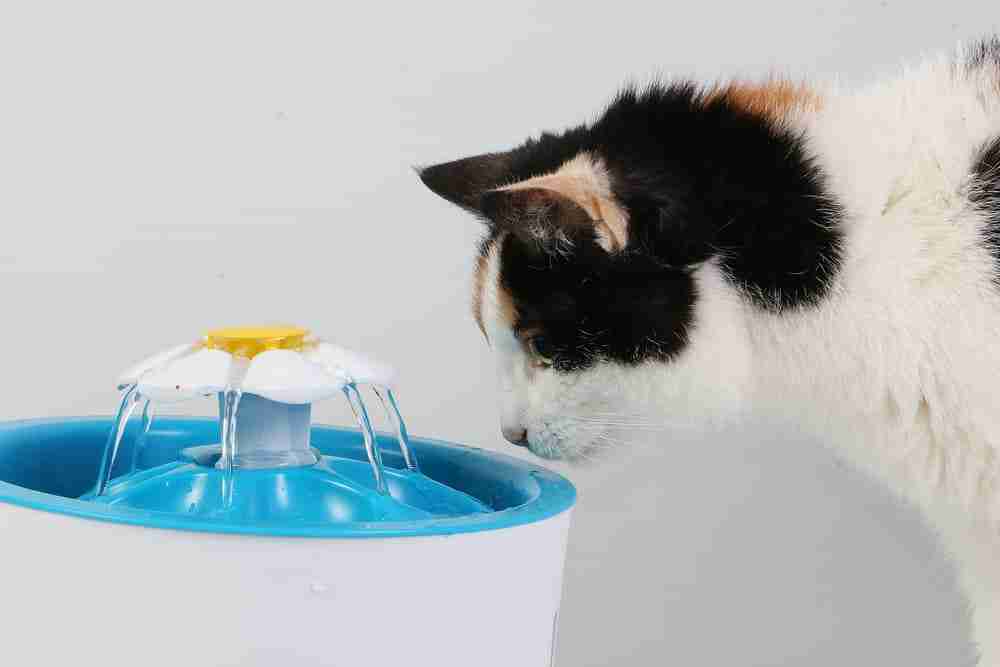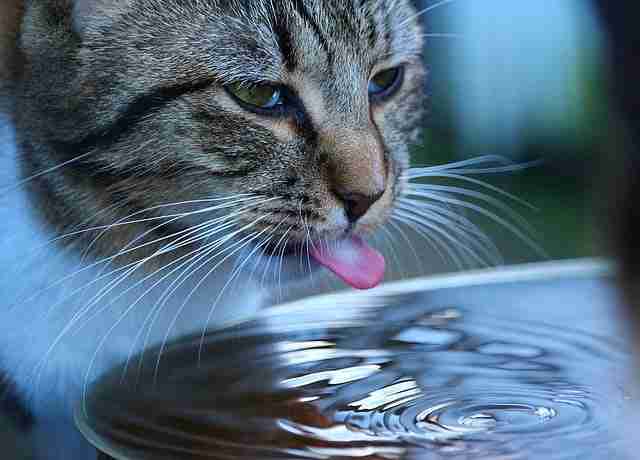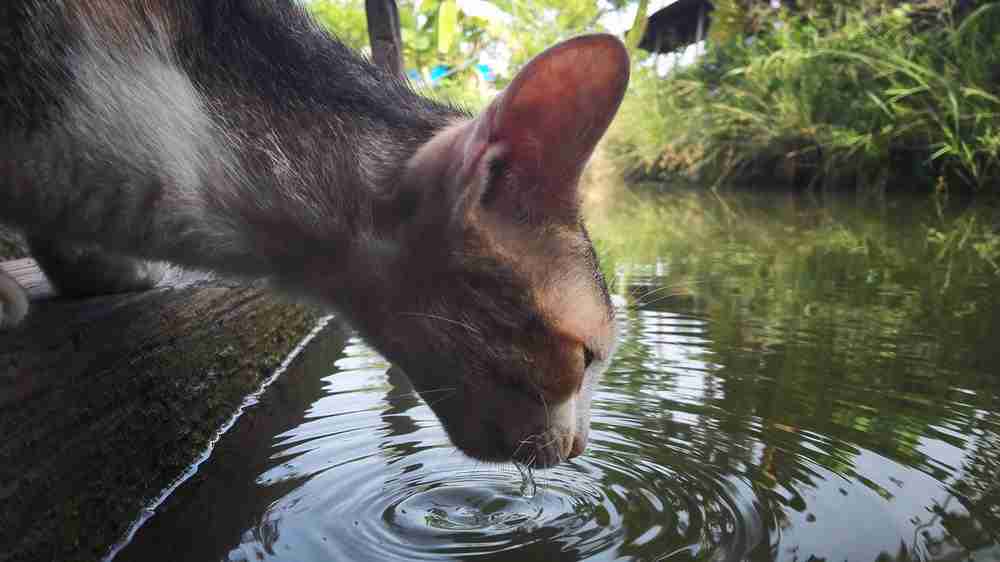You look over at your cat to see her staring blankly into her water dish. After several minutes of staring at the water, your cat is yet to take a drink – that’s strange behavior, right?
Have you got a cat that stares at water but won’t drink? What is going on here?
Water is essential to life. Without it, humans die in a few days. It’s the same for your feline friend; they need water to maintain healthy hydration levels. If your cat slips into dehydration, it could end up dying from the health complications associated with the issue.
If you have a cat looking at water but not drinking, there’s something wrong with the environment, the representation of the water, or your cat’s health – especially if they are drinking from your cups, faucets or puddles outside! This post unpacks the reasons why your cat is avoiding the water bowl.
Why Would My Cat Refuse To Drink Water?
So, why is your cat hovering over the water bowl but not drinking? After all, when we feel thirsty, we sip on a glass of water; it’s not like we’ll pour a glass and stare at it for hours. Surely if your cats feeling thirsty, it will take a drink rather than dehydrate itself?

The reality is your cat will abstain from drinking water, and they might not drink, no matter how thirsty they are. There could be several reasons for this behavior, and all of them require immediate attention to remedy the situation.
If your cat doesn’t drink, it could end up dying in a few days from dehydration. Health issues are the primary concern for your kitty and the common reason why cats stop drinking water altogether. Problems like blood loss, vomiting, kidney disease, diabetes, and heatstroke can all cause your cat to stop drinking. Thyroid issues can also stop your cat from drinking water.
These severe underlying health issues require immediate treatment but your vet to restore your cat’s hydration levels and bring them back to health. However, sometimes, your cat may stop drinking water for reasons unrelated to their health.
These environmental factors are easy to address, but you need to know what you’re looking for before making adjustments to your kitties living environment. If your cat doesn’t have any health issues, start by looking at the following causative factors.
Water Temperature
Cats like to drink cold water. Tepid water temperatures might be offputting. If you’re filling your cat’s bowl with water, they might be waiting around the bowl to see what temperature it is and hoping it is cool enough for them.
Water Presentation
Cats are finicky about their whiskers. They hate it when the whiskers touch the sides of the bowl, and they’ll avoid eating and drinking from deep bowls where they have to lean their head into it to take a drink. Make sure your cat’s water bowl has shallow sides and enough diameter to clear its whiskers.
Dead Water
Some cats don’t like drinking from still water sources, they only like running water. It’s an instinctual habit added down from their ancestors. Still, water is a hiding spot for predators, like crocodiles. While there aren’t any alligators lurking in your cat’s water bowl, it’s an instinct they might have a hard time overcoming.

Water Quality
Cats are clean animals. You’ll probably notice that your cat won’t eat from a dirty dinner bowl, and it’s the same with the water dish. Make sure you empty and clean the water dish for your cat every day. Ensure you rinse out all the soap or detergent from the bowl before filling it with water.
Water Bowl Positioning
Some cats don’t like drinking in certain areas of your home. Check your cat’s response if you put her dish in another corner or area of your home. Cats typically don’t like the water bowl being close to their dinner dish.
What Are The Symptoms Of Dehydration In Cats?
If your cat is sitting by the water bowl but isn’t drinking, it can lead to a trip to the vet’s office. Dehydration is a severe health issue in cats, requiring immediate professional treatment. To check if your cat is dehydrated, pull the skin up between their shoulder blades.
After releasing the skin, it should smooth back to its original shape immediately. If “tenting” occurs, and the skin is slow to recede to its original position, it’s a sign of dehydration.
Along with the tenting test, look for signs of weakness and lethargy in your cat due to the onset of dehydration. Other common signs of dehydration in cats include drooling and panting. Look for signs of a weak pulse, elevated heart rate, and dry or sticky gums.
Your cat may also stop going to the litterbox, signaling they are dealing with severe dehydration. If you notice any of these signs in your kitty, take them to the vet right away. Please don’t assume your cat will start drinking when she feels thirsty.
Dehydration also results in rapid mineral loss and imbalance, causing a host of complications in your cat’s health. Electrolytes and sodium are critical minerals that start diminishing in the wake of dehydration. If your cat experiences severe mineral imbalance due to dehydration, it can result in seizures and death.

How Can I Get My Cat To Drink?
Health disorders causing dehydration in your cat are severe issues that require immediate resolution with your vet. However, chances are your cat is just being picky with its water bowl.
Ensuring that you have the right size water bowl is a good start. If your cat is averse to drinking dead water, take your cat to the kitchen and turn on the sink faucet; if they start drinking the running water – dead water is the issue.
To overcome this problem, purchase a cat water fountain. These devices provide water through a spout, allowing your cat to overcome its issue with drinking. However, make sure you watch your cat’s drinking behavior for the first few days with the fountain.
Some cats are not interested in water fountains but others can get into a habit of drinking too much because they find the experience so enthralling. Make sure you’re giving here room-temperature water, and experiment with positioning the fountain around the room.
If your cat won’t drink water but eats wet food then the issue probably isn’t too serious as they can retrieve as much as 80% of their moisture requirements from wet cat food. If they are eating dry food consider adding water to dry cat food. At least this way your cat will be getting some moisture.
If none of these fixes work to remedy the situation, take your kitty to the vet for a checkup ASAP.
